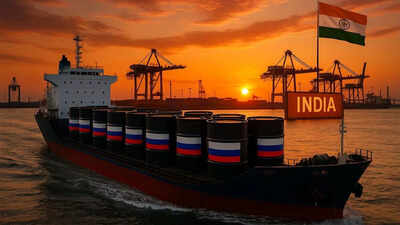ARTICLE AD BOX

The US has responded to India's continued purchase of discounted Russian oil by imposing tariffs on Indian goods. (AI image)
Hit by Ukraine’s drone attacks, Russia’s oil refineries are reeling - but India has turned this crisis in Russia into an opportunity. The substantial price difference between Russian and Middle Eastern oil has attracted Indian refiners.
With Urals crude available at $5-$6 per barrel below Brent prices, this represents considerable savings in an industry where minimal price variations can significantly impact profitability.
Russia’s refining crisis
In August 2025, Ukraine executed its largest drone campaign to date, striking critical facilities within Russia's oil industry. Ukrainian forces conducted attacks on multiple major oil refineries across the country.
The strikes resulted in significant damage to these refining plants, disabling approximately one-fifth of Russia's total refining capabilities and triggering domestic fuel shortages, according to an ET report.The systematic drone strikes affected operations at 10 essential refineries, reducing Russia's processing capacity by over 20%, equivalent to 1.1 million barrels per day (bpd), creating significant challenges for an already pressured system.
The attacks impacted crucial infrastructure including the Syzran refinery, Krasnodar facilities, the Druzhba pipeline, and the Ust-Luga terminal, highlighting vulnerabilities in Russia's energy distribution network.Russia responded by increasing its crude oil exports by 200,000 bpd to international markets. Although this strategy provided short-term solutions, it resulted in reduced domestic fuel supplies, causing difficulties for Russia, the report said.
India capitalises on crisis
India, as the world's third-largest oil purchaser, identified a significant opportunity whilst Russia faced challenges on the other side of the world.According to the ET report, major Indian refiners, including Reliance, Nayara, Indian Oil Corporation, Bharat Petroleum Corporation Limited, and Hindustan Petroleum Corporation Limited, increased their Russian oil procurement. Jefferies analysis suggests Reliance could see an additional $500 million in annual Ebitda.
Whilst this constitutes only 2.1% of projected FY27 consolidated Ebitda, the enduring benefit lies in enhanced refining margins beyond discounted crude prices.Reliance's recent analyst call revealed robust refining performance, with transportation fuel cracks increasing 7%-17% and total O2C Ebitda reaching Rs 14,511 crore, representing a 10.8% annual increase. Despite scheduled crude unit maintenance, Reliance maintained maximum throughput in secondary units, utilising "advantageous feedstock" to enhance profitability.The company's leadership noted India's petrol demand grew approximately 7%, whilst global diesel cracks increased due to geopolitical issues. Reliance maximised these conditions by expanding both domestic distribution and exports to Europe, Africa, and Singapore.Reliance's retail division Jio-bp achieved substantial growth through Russian crude advantages. Their diesel and petrol sales increased by 34% and 39% year-on-year respectively, resulting in 35% overall growth.
Operating approximately 2,000 fuel stations, Reliance has secured over 6% of India's diesel market share and 3.6% of petrol sales, achievements attributed to Russian crude pricing and effective retail strategies.Analysis from CLSA presents a measured perspective, calculating India's annual benefits from Russian crude discounts at $2.5 billion, equivalent to 0.6 basis points of the nation's GDP. Yet, the tangible advantages remain evident, with discounted landed costs, inclusive of logistics and insurance expenses, providing refiners additional margins of $1.0-$1.2 per barrel.Reliance's management noted that the expected European sanctions on Russian diesel could alter market dynamics. They suggested that restricted flows might lead to substantially higher crack spreads, potentially matching the profitable period following 2022 sanctions. Reliance highlighted their Jamnagar facility's adaptability, emphasising their capacity to adjust crude procurement and export destinations, affirming their position as a key market participant.
India’s advantage over China
With Indian refineries operating at maximum capacity, unlike their Chinese counterparts undergoing seasonal maintenance, they can process more Russian oil and increase fuel exports. India's diesel exports to Europe saw a significant rise of 137% to 242,000 bpd in August, coinciding with Europe's efforts to reduce Russian products from its market.According to Kpler's energy analyst Sumit Ritolia, "Exports should stay firm, and European buyers may accelerate liftings of gasoil (diesel) … given that in January 2026, sanctions kick in … This underscores India's pivotal role as a swing supplier of middle distillates to Europe."
US pressure & India’s strategic autonomy
The US has responded to India's continued purchase of discounted Russian oil by imposing additional tariffs of 25% on Indian goods, citing concerns about supporting Moscow's military operations.However, India maintains its position firmly.Finance Minister Nirmala Sitharaman recently said, "India will continue to make sovereign decisions about its energy supplies based on affordability, reliability, and national interest.
Our responsibility is to ensure affordable energy for our people."Additionally, diplomatic relations with Russia strengthened as Prime Minister Modi's meeting with Putin in Tianjin reinforced their "special and privileged" partnership, with Putin planning to visit Delhi in December.
India's crude trade with Russia: Will the gains last?
Recent analysis from Kpler highlights the precarious nature of India's current advantages. They indicate that the Urals crude discount, which fluctuates based on refinery operational status, could disappear if Russia successfully repairs its facilities or implements new strategic measures.Calculations suggest that losing the $5 per barrel discount on 1.8 million bpd would increase India's annual import expenses by $9-$11 billion.The expansion in India's diesel exports, particularly during EU sanctions, is enhancing refinery profits. However, this development could subject Indo-Russian relations to increased geopolitical pressures, specifically if US tariffs increase or new trading alternatives become available.Reliance faces dual opportunities: immediate benefits from substantial refining margins and discounted crude supplies, alongside strategic advantages as European markets seek reliable suppliers. The company's leadership notes that "overall margins may actually be constructive" should sanctions intensify, maintaining elevated margins.While India has successfully capitalised on current market conditions, this strategy carries significant risks, influenced by ongoing developments in international conflicts, diplomatic relations, and global energy sector dynamics.



.png)
.png)
.png)
















 1 hour ago
4
1 hour ago
4









 English (US) ·
English (US) ·